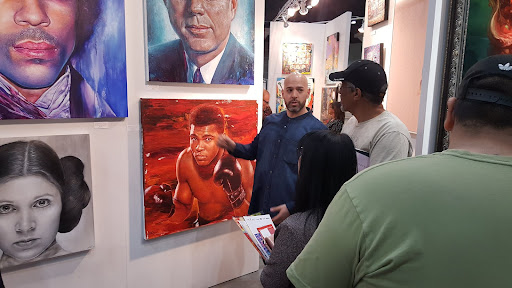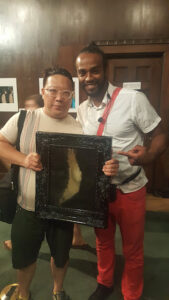Technically, anyone can collect art.

Great artworks by notable artists cost a fortune, so art collecting seems exclusive to the extremely wealthy. But do you really have to be rich to collect art?
It takes extravagant financial means to start and build an art collection of ‘blue chip’ or famous pieces that appreciate significantly and predictably. But technically, anyone can collect art.
Whether just anybody can profit from collecting art is a different question. Either way, we have everything you need to know about the profit potential of art collecting, whether you have to be rich to collect art, and how to make an art collection on a budget.
It takes extravagant financial means to start and build an art collection of ‘blue chip’ or famous pieces that appreciate significantly and predictably. But technically, anyone can collect art.
Whether just anybody can profit from collecting art is a different question. Either way, we have everything you need to know about the profit potential of art collecting, whether you have to be rich to collect art, and how to make an art collection on a budget.
Is Art Collecting Profitable?
The answer is more complex than ‘yes’ or ‘no,’ since so many variables affect the value of art collections. Art usually does not surge in value. But art is a safe investment, and it can be profitable for informed collectors:
Art is a Long-Term Investment
Experts say only patient investors should pursue art collecting because art is a long-term investment. It can take a decade or longer for an art collection’s value to increase enough to justify the investment (8-9% returns).
Additionally, art is an illiquid, a.k.a. non-liquid asset, meaning it takes time and work to convert art into cash. So even if you own priceless art, it can take a long time to sell it. As a result, a lot of art investors do not sell their art. So why purchase art in the first place?
Additionally, art is an illiquid, a.k.a. non-liquid asset, meaning it takes time and work to convert art into cash. So even if you own priceless art, it can take a long time to sell it. As a result, a lot of art investors do not sell their art. So why purchase art in the first place?
Art is a Stable Investment
While profit is possible, investors should not expect art to yield regular income or dramatic returns. Rather, art collections are a trustworthy method for preserving wealth when included as a small segment of a portfolio. This is because art’s value normally stays the same or increases despite unfavorable economic conditions.
Thus, investors use art collections to hedge inflation and diversify investment portfolios for risk reduction. Many art investors also include art in their estates to leave behind as an inheritance to their descendants.
Thus, investors use art collections to hedge inflation and diversify investment portfolios for risk reduction. Many art investors also include art in their estates to leave behind as an inheritance to their descendants.
Collecting Art Has Indirect Costs
Auction houses are one of the most reliable ways to buy and sell art, but they charge considerable fees for their services. Plus, collectors of physical art pieces have to pay for appropriate maintenance and storage to prevent deterioration and depreciation. And if art does see any gains, the investor has to pay taxes on them.
For any chance at profiting from art collection, keep in mind the duration of the investment, its illiquidity, the slow and steady nature of gains, and the costs associated with owning art.
For any chance at profiting from art collection, keep in mind the duration of the investment, its illiquidity, the slow and steady nature of gains, and the costs associated with owning art.
Do You Have to Be Rich to Collect Art?
The likelihood of profiting from art is much stronger for the wealthy, who have access to the highest quality art. But not all good art is expensive.
Almost anyone can collect art. For example, Millennials hold only 4-5% of the total wealth, lagging far behind Baby Boomers and Gen X. Yet, Millennials now account for 49% of the world’s art collectors. The takeover of young art collectors is related to the past couple of years’ online art buying and NFT craze.
Almost anyone can collect art. For example, Millennials hold only 4-5% of the total wealth, lagging far behind Baby Boomers and Gen X. Yet, Millennials now account for 49% of the world’s art collectors. The takeover of young art collectors is related to the past couple of years’ online art buying and NFT craze.
How to Start An Art Collection
Know the Art Market
You already have a fondness for art, so it should be exciting to get involved in art circles at galleries, fairs, and graduate student art exhibitions to explore what art you enjoy and what is valuable. While you get started in art collection, connect with artists, curators, and gallerists to stay informed. Also, feel out how the art market works by researching online and keeping up with auction houses.
Know What to Buy
Pay attention to artists who create artwork you like. To gauge an artist’s potential career trajectory, watch for achievements such as work featured in famous collections or museums, awards, and formal recognition. This will also influence your budget.
Know Where and How to Buy
Depending on what you want, you can go to the artist directly, a gallery, art show, or auction house. You can also buy art through galleries and auction houses online and on NFT/digital art marketplaces.
Consult professional expertise. Art dealers, advisors, investment companies, and auction houses are helpful resources for starting an art collection, but they also come with fees such as commissions, retainers, and buyers’ premiums. Remember to have a professional appraise the art. Obtain and safely keep documentation of art pieces’ provenance and authenticity.
Consult professional expertise. Art dealers, advisors, investment companies, and auction houses are helpful resources for starting an art collection, but they also come with fees such as commissions, retainers, and buyers’ premiums. Remember to have a professional appraise the art. Obtain and safely keep documentation of art pieces’ provenance and authenticity.
Know What You’re Getting Into
Contemporary art is popular among collectors, but it is unpredictable because of the unknown about how an artist’s reputation will change and how their value will fluctuate. Therefore, start a well-rounded collection of varied styles and multiple artists to be safe.
When calculating your budget, anticipate dealer, advisor, and appraisal fees, travel costs, buyer’s premiums, sales taxes, capital gains taxes, storage, and maintenance.
When calculating your budget, anticipate dealer, advisor, and appraisal fees, travel costs, buyer’s premiums, sales taxes, capital gains taxes, storage, and maintenance.
Tips on Starting an Art Collection on a Budget
Never pay more for an art collection than you can afford to lose, and always verify legitimacy.
Once you have researched and set a realistic art collection budget, you know how much to spend on the art itself and where to purchase the art you want.
Never pay more for an art collection than you can afford to lose, and always verify the legitimacy of a gallery, dealer, investment firm, or online platform/source. But there are plenty of valid and affordable options to start an art collection on a budget:
Never pay more for an art collection than you can afford to lose, and always verify the legitimacy of a gallery, dealer, investment firm, or online platform/source. But there are plenty of valid and affordable options to start an art collection on a budget:
Try Fractional Investing
You own shares, or small portions of expertly authenticated quality artwork, and the platform updates you on the state of your investment. You will save money on maintenance and storage, and some fractional art investing platforms do not have minimum investment amounts.
Start Small
Purchase smaller pieces by an artist you love. Or start a collection of limited edition prints or photography. World-renowned art events frequently attract smaller satellite fairs showing more budget-friendly art.
Go Online
There is no guarantee that art by a less established artist or gallery will eventually explode in value, but you have an opportunity to seek artwork you adore. No matter what you can afford, your main inspiration for starting and building an art collection should be a passion for art and buying something that enriches your life.
Buy What Delights You
There are countless artists and artwork to find and follow on social media for any price range. Sites like Instagram are overflowing with talent. Buying directly from the artist comes with a far more modest price tag. Try out digital art and NFT marketplaces as well. These marketplaces charge fees, but they are nothing compared to buying physical works of fine art.
DotRed and the Future of Art Collection
DotRed’s hybrid art gallery exhibitions aim to revolutionize the future of art collections. Discover how our innovative and immersive platform can connect aspiring collectors with special artworks to experience and artists to support.




